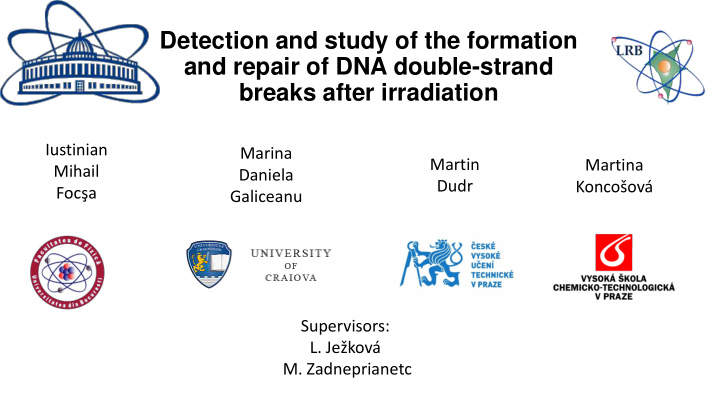



Detection and study of the formation and repair of DNA double-strand breaks after irradiation Iustinian Marina Martin Martina Mihail Daniela Dudr Koncošová Focşa Galiceanu Supervisors: L. Ježková M. Zadneprianetc
Effect of radiation on organisms Radiation is: -ionizing, dangerous for living organisms -non-ionizing, mostly harmless The most harmful effect of the ionizing radiation is DNA damage. DNA DSBs are the most dangerous type of IR-induced DNA damage because it is hard to repair properly. Repair processes: Homologuous Recombination - error-free Non-Homologuous End Joining - error-prone, dominant in human cells
Immunostaining process Human fibroblasts: cells mainly found in connective tissues that secrete collagen fibers secondary antibodies with fluorescent dye primary antibody γ H2AX protein signaling the damage 53BP1 protein involved in repair DNA DSB
γH2AX Mergence of 53BP1 signal the signals signal
Goal of the project : study of DSBs induction and repair in human fibroblasts under the effect of γ radiation Project motivation : fundamental research, applications in medicine and space exploration
Work in the laboratory
Simplified procedure Immunostaining of the cells at Cultivation of the Irradiation different times fibroblast (D = 1 Gy) Image acquisition (take photos Data processing of the cells)
Results
Distributions of frequency
Conclusions • Maximum of γ H2AX/53BP1 foci found 1 hour after gamma-irradiation (1 Gy) • 80% of foci disappeared in first 4 hours after irradiation • After 1 day only 8% of foci were present • DSB repair processes in human fibroblasts are considerably efficient
Thanks for your attention :-o
Recommend
More recommend